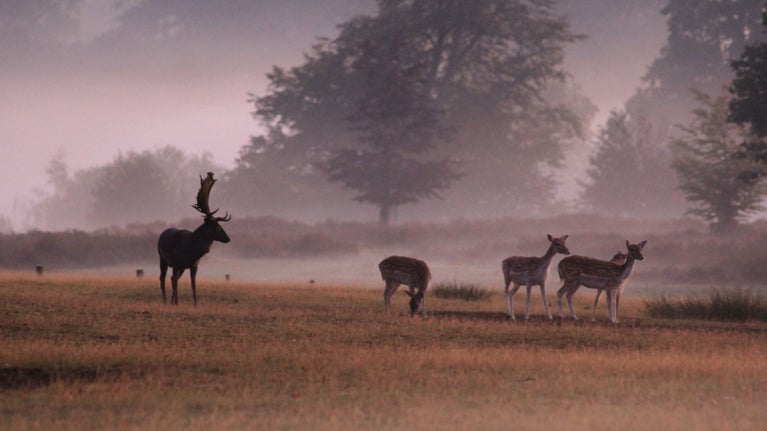
Discover more at Knole
Find out when Knole is open, how to get here, the things to see and do and more.

It’s hard to miss the fallow deer in Knole’s parkland. They are owned and managed by the Sackville family's Knole Estate. Whilst the National Trust doesn’t manage the herd, or the entirety of the park, it’s important to us that everyone has the best experience possible, so here are some dos and don’ts.
Unfortunately, many visitors to Knole are tempted to feed, touch or even pick up these wild animals. We know they look cute, but we can’t state strongly enough that it's essential to resist the temptation. The herd should be treated like any other grazing livestock, such as cattle, and viewed from a distance. And please don't try to feed them anything.
Deer will eat whatever food they are offered by park visitors (including fruit and vegetables). This is not part of their natural diet and will be harmful to them. They will associate humans with food and pester visitors. The deer are wild and powerful animals. They become aggressive when pestering for food.
The natural plant life at Knole provides more than enough nutrients for the deer, and as well as grazing on acorns, conkers and sweet chestnuts during winter months, their natural diet is supplemented.
It is equally important to pick up your litter so that the deer do not chew or ingest it, which may fatally harm them. An increase in visitors and picnics has led to a rise in litter being left around the park. Please take your litter home for disposal.

Sometimes it’s hard to avoid contact as many of the deer will happily approach people in the hope of food, but this is chiefly as a result of becoming used to humans getting too close to them. If a deer does approach you, ignore it and move away from the area. So, to all you deer lovers out there, please, please do not feed these beautiful creatures.
Please keep your dog on a lead at all times whilst in the park. Just like a herd of cows, the deer in the park are wild, unpredictable animals that roam freely and can feel threatened by dogs. Unfortunately, the deer have been fatally attacked by dogs off lead in the park.
All woodlands and parks can attract ticks. Lyme disease is a bacterial infection spread to humans by infected ticks, which feed on the blood of birds and mammals, including humans. If you touch or feed the deer you could increase your chances of being bitten by a tick.
To familiarise yourself with symptoms and things you can do to prevent tick bites, visit the NHS website
Did you know there have been deer at Knole for over 500 years? Knole’s medieval deer park is the last of its kind in Kent. The park was created in 1456 when Archbishop Bourchier first enclosed the area with a fence to make a park for deer hunting. Fallow deer have freely roamed the parkland ever since.
If you want to learn about the herd, come along to a deer keeping session or guided walk that take place regularly throughout the year. There are plenty of opportunities to get involved and ask questions. Please visit the ‘what’s on’ section on our home page for full details.

By December the deer have grown their thick winter coats. During cold weather they’ll tuck themselves up in the wooded areas of the park. Their antlers are still fully grown following the rut in autumn. When the deer are looking for food in winter they can be quite aggressive. They are powerful animals and you might see them stand up on their hind legs to shake leaves and acorns from the trees. This is why it’s important the deer don’t associate humans with food. Knole Estate’s Park & Deer Keeper will top up the herd’s feed as needed with special pellets, but he never feeds them by hand.

Find out when Knole is open, how to get here, the things to see and do and more.

The parkland at Knole is a designated Site of Special Scientific Interest (SSSI), covering 1,000 acres of trees, undulating valleys, open parkland and is home to a herd of wild deer.

Knole is a two pawprint rated place, with acres of parkland to enjoy with your dog. Here's what you need to know before you set off.